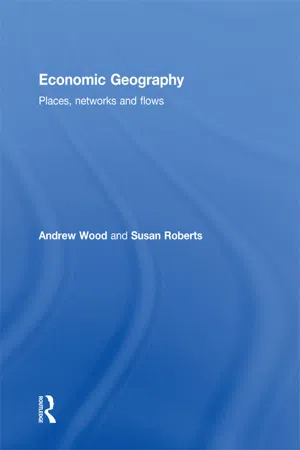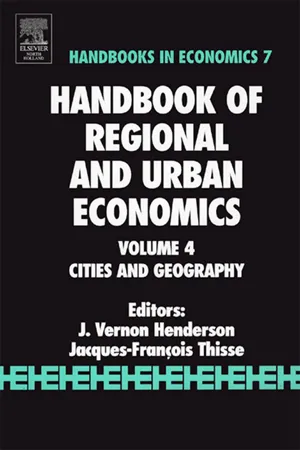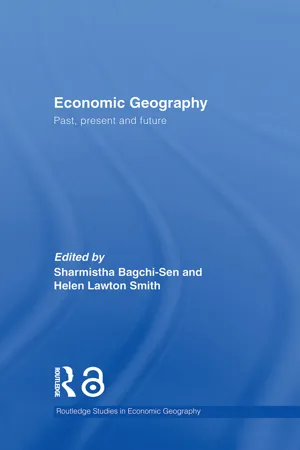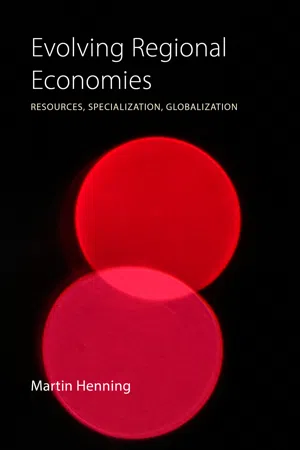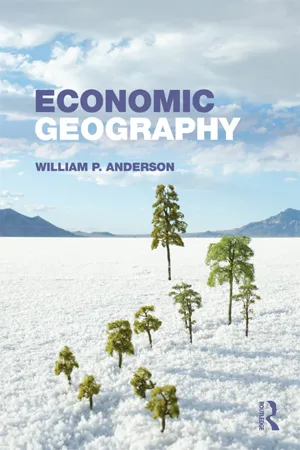Economic Geography
Economic geography is the study of how economic activities are organized and distributed across different locations. It examines the spatial patterns of production, consumption, and exchange, as well as the factors that influence these patterns, such as resources, technology, and government policies. This field also explores the impacts of globalization, trade, and urbanization on economic landscapes.
7 Key excerpts on "Economic Geography"
- eBook - ePub
Economic Geography
Places, Networks and Flows
- Andrew Wood, Susan Roberts(Authors)
- 2012(Publication Date)
- Routledge(Publisher)
...Economic geographers have long been interested in the ways in which local and regional economies are transformed. The concern stretches back to the German location theorists examined in Chapter 2. In Chapter 7 we examine why local and regional economies might continue to matter in the face of the globalization of economic activities and practices. The dispersal of economic activities examined in Part II is countered by persistent forces of clustering and agglomeration that we examine in Chapter 7. The clustering of economic activity remains a powerful trend and in Chapter 7 we examine the new forms of clustering that have emerged as the western economies have shifted to post-Fordist forms of development. 6 GEOGRAPHIC INEQUITIES While a focus on key economic institutions, notably the firm, has been a longstanding emphasis in Economic Geography, there is another, and competing, tradition in the sub-discipline. Employing key concepts drawn from political economy many economic geographers, especially in the 1970s and on, found that they could begin to construct powerful analyses. For many political economy inspired economic geographers, it is the highly uneven nature of capitalist development that needs explanation. Both the uneven and unequal incorporation of different groups of people and the uneven development of spaces – from continents to streets and alleys – demand analysis not just because they were, and still are, intriguing aspects of the world we live in, but because for many economic geographers, ourselves included, the inequities engendered by capitalist development represent a major social failing. Before there was economics (and Economic Geography) there was political economy. Classical political economy developed in the eighteenth century...
- eBook - ePub
Great Minds in Entrepreneurship Research
Contributions, Critiques, and Conversations
- Vishal K. Gupta(Author)
- 2020(Publication Date)
- Palgrave Macmillan(Publisher)
...Notably, Sorenson has also written on other topics, such as the non-distinctive domain of entrepreneurship research (Sorenson & Stuart, 2008a), role of theory testing and replication in management science (Shi, Sorenson, & Waguespack, 2017), and formal theorizing to strengthen knowledge development in management research (Adner, Polos, Ryall, & Sorenson, 2009). Sorenson (2018) credits his interest in Economic Geography as the starting point of his journey into entrepreneurship research. 9 Krugman (1991 : 1) defines Economic Geography, based on the idea of “the location of production in space,” as the “branch of economics that worries about where things happen in relation to one another.” Economic Geography can also be defined as the study of “the spatial distribution of economic activity, in why regions grow at different rates, and in the fundamental principles underlying cities and the structure of urban systems” (Rodríguez-Pose, 2001 : 178). Because economic activities are unevenly distributed in space, the field of Economic Geography is concerned with explaining spatial variations in economic activities that can be accounted for by the natural differences between places (e.g., variations in climates, accessibility, and natural endowments; Ottaviano & Thisse, 2005). Many industries in the US, and elsewhere, show geographical concentration (e.g., high-tech industry and motion-picture industry), which has generally been explained as organizations benefiting economically from locating efficiently. Do decision-makers really make carefully thought-out economic decisions about the efficiency of their location choices? Based on a historical analysis of show manufacturing plants in the US from 1940 to 1989, Sorenson and Audia (2000) find that states with high geographical concentration of shoe manufacturing see both high founding and failure rates...
- eBook - ePub
Handbook of Regional and Urban Economics
Cities and Geography
- V. Henderson, J.F. Thisse(Authors)
- 2004(Publication Date)
- North Holland(Publisher)
...in the spatial distributions of population, employment and wealth are a universal phenomenon in search of a general theory. At a high level of abstraction spatial imbalances have two possible explanations. 3 First of all, uneven economic development can be seen as the result of the uneven distribution of natural resources. This is sometimes called ‘first nature’ and refers to exogenously given characteristics of different sites, such as the type of climate, the presence of raw materials, the proximity to natural ways of communication, etc. First nature is clearly important to explain the location of heavy industries during the Industrial Revolution, because the proximity of raw materials was a critical factor, or why Florida keeps attracting so many (retired) people. However it falls short of providing a reasonable explanation of many other clusters of activities, which are much less dependent on natural advantage (think of the metropolitan area of Tokyo or the Silicon Valley). 4 The aim of geographical economics is precisely to understand what are the economic forces that, after controlling for first nature, account for ‘second nature’, which emerges as the outcome of human beings’ actions to improve upon the first one. From a methodological point of view, geographical economics starts with considering an initial situation in which space is homogeneous and production activities are equally present at all sites. Then, it asks what are the forces that can allow a small (possibly temporary) asymmetric shock across sites to generate a large permanent imbalance in the distributions of economic activities. Among the various classes of models that have been put forth to address this question, we focus on the so-called new Economic Geography (in short NEG). NEG has been initiated by three authors, namely Fujita (1988), Krugman (1991) and Venables (1996) who all use general equilibrium models with monopolistic competition...
- eBook - ePub
Economic Geography
Past, Present and Future
- Sharmistha Bagchi-Sen, Helen Lawton-Smith, Sharmistha Bagchi-Sen, Helen Lawton-Smith(Authors)
- 2006(Publication Date)
- Routledge(Publisher)
...Significant contributions came from non-geographers such as the role of service industries in economic development, uneven distribution of producer services, connections between society and the rise of the service sector among others. During the 1980s and early 1990s, economic geographers highlighted the fact that producer services are the key to understanding the basic function of services in urban or regional economies. After the mid 1990s, economic geographers examined the role of producer services in global networks and the characteristics of particular types of services. Daniels reminds us that: Research on the relationship between developments in information and communications technology (ICT) and the supply, demand, quality and spatial distribution services is far from exhausted, not least as offshoring and outsourcing of both routine and higher-order service tasks presents economic challenges to some developed economies and opportunities for newly emerging economies. David Angel offers how several topics attracted enquiries in environmental Economic Geography: an examination of the evolution in patterns of environmental regulation of firms and industries, higher level of scrutiny of firms’ activities around the world, and climate change and environmental challenges. Currently, the approaches of study of environmental Economic Geography include the greening of industry and the political ecology of industrial change. For the greening of industry approach, researches are firm-centred and mainly fall into three categories: consequences of changes in global production networks for economic development, technological innovations and environmental performance, and flows of capital, technology, and information and the dynamic of economic globalization...
- eBook - ePub
Evolving Regional Economies
Resources, Specialization, Globalization
- Martin Henning(Author)
- 2022(Publication Date)
- Agenda Publishing(Publisher)
...So far, there is still a geographical interaction cost associated with this, whether it is a traditional transportation charge or a loss of information. Also, geography is actually not only about physical distance but about the institutions and power relations that influence how different places link to each other too. There are different forms of “proximities” apart from geographical proximity – cognitive, organizational, social and institutional – that relate to geography in different ways and affect the outcomes of economic transactions in space (Boschma 2005). 2. During globalization, economic activities take place in particular localities for a reason, and regions specialize. This means that regions often develop distinct production profiles or even clusters. It is common that regions become widely associated with their economic specialties. Silicon Valley (IT), Hollywood (film and entertainment), the City of London (financial activities), Ingolstadt (automobiles), Nagoya (air and aviation industries) and Bangalore (IT services) are just some of the well-known regional specializations. Apart from these, there are thousands of less famous regional specializations across all economies. There is a reason for that, or actually several. Places are still important. 3. Some regions have a difficult time escaping their economic past. The Ruhr area in Germany, for example, once the industrial heartland of the European continent, has struggled to remain relevant in a time of deindustrialization and a growing service economy. Much the same goes for old industrial regions in the UK, the USA, Scandinavia and eastern Europe. Places, or rather what they contain, seem to matter not only “now” but for the “future” too. These examples suggest that we need to consider space and place if we want to understand how the economy unfolds over time and how that affects people. This is true in a globalized economy too...
- eBook - ePub
- William P. Anderson(Author)
- 2012(Publication Date)
- Routledge(Publisher)
...But even this brief treatment should be sufficient to illustrate that the transition from a local world to a global world does not undermine the study and methods of Economic Geography. For example, the strategy of the global firm arises in large part from two classic themes in Economic Geography: differentiated space and the trade-off between scale economies and transportation costs. Differentiated space means that a variety of factors that vary across the map – labor costs, skills, natural resources, energy prices, infrastructure, political stability and many more – make some places more advantageous than others for a given production step. But there may not be a single best place for every step in the production process. Since the different steps have different requirements, they will have different best locations. From the perspective of production efficiency, the best thing is for every step to take place in its best location, not only because this strategy exploits spatial differentiation but also because it maximizes any scale economies that can be achieved at the level of a single step. However, since goods in process must pass from one step to the next, such a dispersed configuration of production will have high transportation costs, which at the global scale include the costs of crossing borders. Thus, the global firm faces a problem of balancing locational advantages, scale economies and transportation costs. This is a much more complex problem than the simple location models presented in Part III, but it involves many of the same principles. An effect of globalization is to increase the geographical scope of economic decision making. Firms routinely make decisions between sourcing inputs from factories located 10,000 km apart. It may be impossible to attribute more than about 30 percent of the value of a complex electronic device to any single country...
- eBook - ePub
Regional Geography (RLE Social & Cultural Geography)
Current Developments and Future Prospects
- Ron Johnston, Joost Hauer, G. Hoekveld(Authors)
- 2014(Publication Date)
- Routledge(Publisher)
...Certainly, not only is the geography of the current transformation remarkably varied and dynamic, but geographical restructuring is a centrally important feature of it. In accounting for the change from organized to disorganized capitalism, Lash Scott Lash and John Urry (1987:84) argue that ‘there is in the spatial an aspect of social relationships’, that there are ‘particular spatial patterns associated with each of these phases of capitalist development’, and, in elucidating ‘what it is like to be “modern”, to live in a modern age’, they stress the ‘extraordinary spatial and temporal transformations … that substantially organize our experience of modern social life’. Not surprisingly, then, the diversity of transition and the fragmentation of previous wholes has led to an increased concern with the geographically distinctive and local and has encouraged a mode of theorizing which stresses fragmentation and unintended consequences. This, I would argue, is extremely dangerous. ‘We still live in a world dominated by capitalism’, and ‘broad social change’ cannot be reduced to the ‘inchoate swirl of human agency’ (Harvey and Scott 1989). Related to this is Neil Smith’s (1987b) critique of realism in which the distinction between necessary and contingent relations leads to the conclusion that, as a product of contingent relations, geography is not accessible to abstract theory. If our objective is to change rather than merely to understand the world, the significance of regional geography lies in reminding us of the ever-present possibilities of making alternative geographies. If the ‘essence of the intellectual enterprise we are engaged in is to construct sustainable generalizations’, regional geography enables us to ‘judge when these generalizations are no longer sustainable’ (Smith 1987b:67)...
